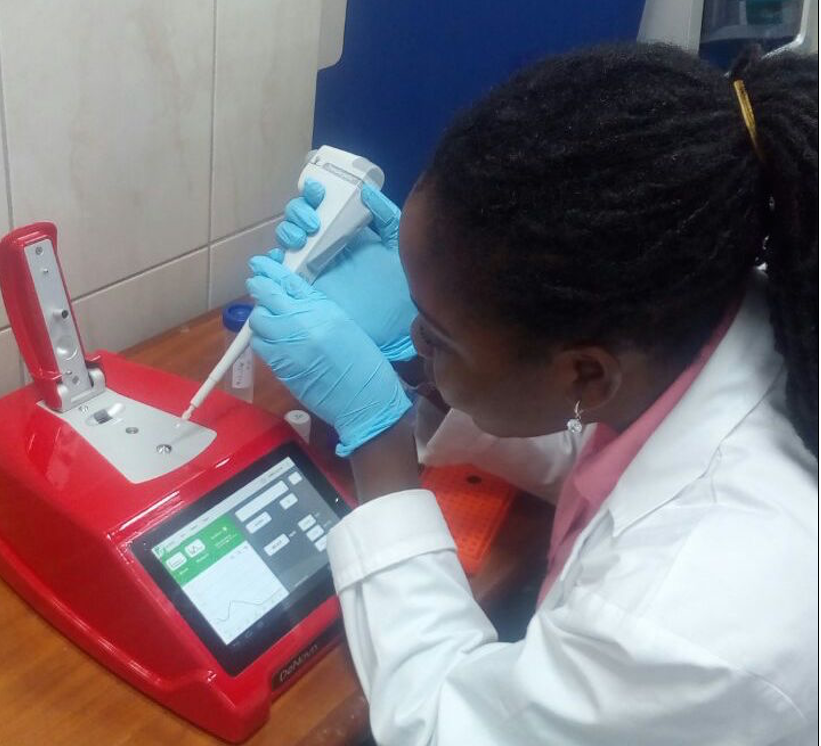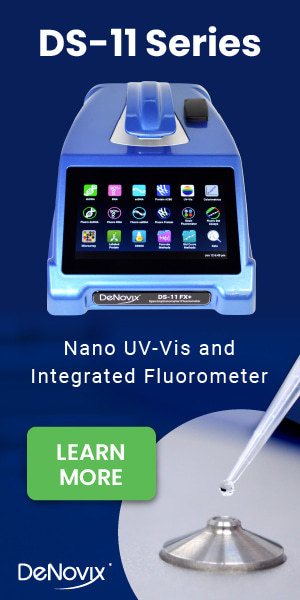Sponsored Content by DeNovix Inc.Reviewed by Louis CastelSep 1 2022
A method for measuring light absorption throughout the ultraviolet and visible regions of the electromagnetic spectrum is known as ultraviolet-visible (UV-Vis) spectrophotometry. Incident light can either be absorbed, reflected, or transmitted when it interacts with materials.
Atomic excitation, which describes the transformation of molecules from a low-energy ground state to an excited state, is brought on by the absorption of light in the UV-Vis range.

Image Credit: DeNovix Inc.
An atom must absorb enough radiation for electrons to migrate into higher molecular orbits before it can change excitation states. The absorption of shorter light wavelengths is often correlated with shorter bandgaps.
Therefore, the energy needed for molecules to go through these transitions is electrochemically unique. This concept can be used to quantify the analytes in a sample based on their absorption properties using a UV-Vis spectrophotometer.

Image Credit: DeNovix Inc.
Outlining UV-Vis spectrophotometers
A UV-Vis spectrophotometer gauges the amount of light passing through a sample in contrast to an incident light source reference measurement.
A pulsed Xenon flash lamp is used in the widely known DS-11 series of UV-Vis spectrophotometers from DeNovix to examine microvolume samples with light ranging in wavelength from 190 to 840 nm. A CCD optical detector with a wavelength precision of 0.5 nm collects the transmitted light.
The Beer-Lambert Law states that there is a linear relationship between the amount of light absorbed and the sample’s concentration. The greater the distance the light travels through the sample (the pathlength), the more light is absorbed.
By adjusting the analytical wavelengths and pathlength, UV-Vis spectrophotometers can consequently be used to calculate the concentration of certain analytes in a microvolume.
Unlike any other UV-Vis spectrophotometer currently on the market, the DS-11 is integrated with patented SmartPath®Technology, which enables accurate readings of samples over a greater dynamic range and ensures the optimum pathlength for each sample.
The ideal pathlength for each sample is determined using real-time absorbance, and automated modifications are then made to fit the detection range of the apparatus.
The DS-11 series also enables quartz or plastic cuvettes as well as microvolume measurements. The concentration, entire spectral output, and sample purity of proteins, single- and double-stranded DNA (ssDNA and dsDNA), and ribonucleic acid (RNA) can be evaluated quickly and automatically using either measurement mode.
DS 11 Series | Spectrophotometer | Fluorometer
UV-Vis spectrophotometers from DeNovix
DeNovix offers a number of UV-Vis spectrophotometer devices in the DS-11 series for the highest level of accuracy and dynamic range. Microvolume, cuvette, and fluorescence measuring modalities are among the models.
About DeNovix, Inc.
WELCOME TO DENOVIX
Award-Winning products for Life Science
Our multi-award winning products include the Reviewers’ Choice Life Science Product of the Year and Platinum Seal awarded- DS-11 Series Spectrophotometer / Fluorometer and CellDrop™ Automated Cell Counter. CellDrop is the first instrument of its kind to Count Cells Without Slides. These powerful instruments integrate patented DeNovix technology with easy-to-use software designed by life scientists for life scientists.
Researchers tell us they love the industry leading performance, smart-phone-like operation, and the flexible connectivity of the instruments. When support is needed, the DeNovix team is here to help. DeNovix received the prestigious Life Sciences Customer Service of the Year based on independent reviews posted by scientists worldwide!
CellDrop: Sustainable laboratory product of the year
The CellDrop Automated Cell Counter has been awarded Sustainable Laboratory Product of the Year in the SelectScience® Scientists’ Choice Awards®!
CellDrop’s patented DirectPipette™ technology distinguishes it as the only cell counter to eliminate the need for cell counting slides. This innovation saves millions of single-use plastic slides from use and disposal each year.
Sponsored Content Policy: News-Medical.net publishes articles and related content that may be derived from sources where we have existing commercial relationships, provided such content adds value to the core editorial ethos of News-Medical.Net which is to educate and inform site visitors interested in medical research, science, medical devices and treatments.